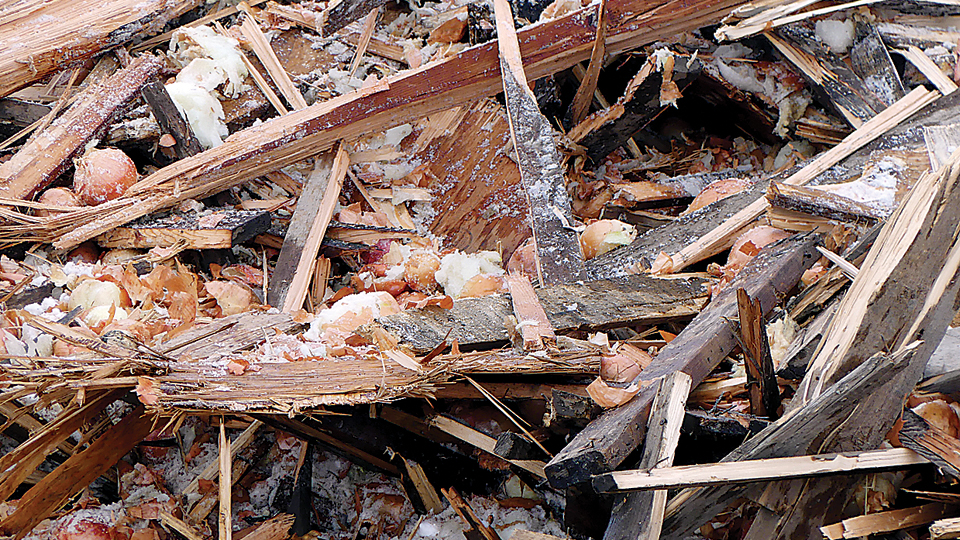
 Ruined onions are strewn amid the rubble of a collapsed storage shed, after January’s snows overpowered roofs across the region.
Ruined onions are strewn amid the rubble of a collapsed storage shed, after January’s snows overpowered roofs across the region.(The Enterprise/Pat Caldwell)
Pat Caldwell
The Enterprise
NYSSA – The area’s onion industry suffered an estimated $100 million in damage from winter storms, according to the president of the Malheur County Onion Growers Association.
Paul Skeen, the president, said Friday that the onion industry suffered a disaster on the scale of Hurricane Katrina, which devastated New Orleans.
Skeen said onion producers, farmers and ranchers must help get the word out about the magnitude of the catastrophe.
“This has the potential to be devastating to the onion industry in this valley if we do not get the storages and packing facilities up and running again by this fall. That is why it is so important to get all the state and federal help we can to assist us in this process,” he said.
The critical question is what will be the final price tag from the winter disaster.
“That is the big question,” Skeen said.
So far specific numbers are hard to come by but Skeen estimated that the damage for just structural loss and cleanup locally to be around $100 million.
“Those loss figures are just an estimate and do not include the losses on the Idaho side,” he said.
Stuart Reitz, Extension Service cropping systems agent, agreed.
“That will be in the ballpark. And we are not done with it (winter) yet. I had a grower who lost a building a couple of days ago. The buildings are stressed and sooner or later they give out,” he said.
Reitz said the damage assessment report is critical for many producers.
Reitz said the information collected will be pushed on to the Oregon Congressional delegation in an attempt to secure federal aid.
“So the legislators can make a direct appeal to FEMA (Federal Emergency Management Agency). We will let everyone know. We want that information to get out to let people know how significant it has been,” he said.
“People have had buildings collapse and it turns out their insurance doesn’t cover it, or they didn’t have insurance,” he said.
Skeen is urging producers to report in to Reitz.
“If you have your numbers and you have an onion storage that is full or partially full or empty and you have had troubles or a shed that went down, call Stuart and let him know,” Skeen said.
Reitz said the area received more than 40 inches of snowfall so far this winter.
“The high point for snow on the ground was about 28 inches as of a few weeks ago. Obviously that depends on location. No matter where you are it has been a bad winter,” he said.
Skeen said two of his storage sheds – one he owned, the other rented – were damaged. The cost to his operation, he said, could reach $600,000.
The loss of overall onion storage capacity is a big concern, Skeen said.
“That is my scare for people in this valley — that there will be an onion harvest that will need to go into storage and I worry it will not be there,” he said.
The impact of the damage will be felt for months, Reitz said.
“It has definitely been a blow. It will have a ripple effect down through the next season. One, because the storage that went down, are those going to be replaced? How much are people going to grow? And we don’t know when the snow will melt and they can get into their fields,” he said.
Skeen said Malheur County is the single largest onion-growing county in America.
Some onion producers and packers were more fortunate than others.
For example, Murakami Produce Company LLC in Ontario didn’t have any collapses. That didn’t mean the weather was not a challenge, said general manager Grant Kitamura.
“It has been a very expensive task moving snow. It was a very expensive month,” he said.
Recently, onion prices – partially driven by the fact that the Treasure Valley’s onion industry was hit hard by the winter storms – climbed to $10 per 50-pound bag. They had been selling for $3.50 before the snowstorms.
Skeen said another challenge onion producers now face is what to do with the ruined onions. While there is no official tally of how many tons of onions are ruined and need to be disposed of, he said the figure is high.
“We’ve got a lot of farmers and ranchers affected by this,” he said.




